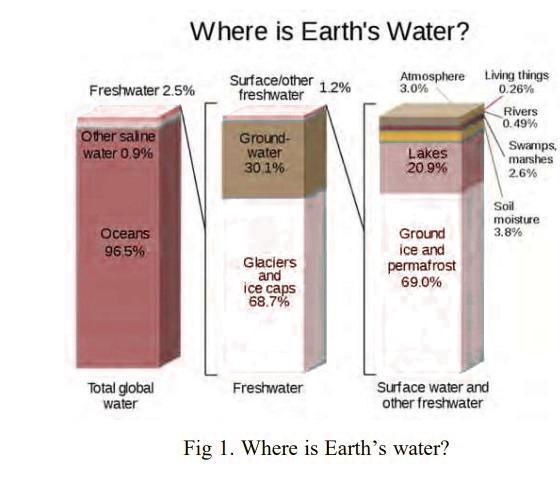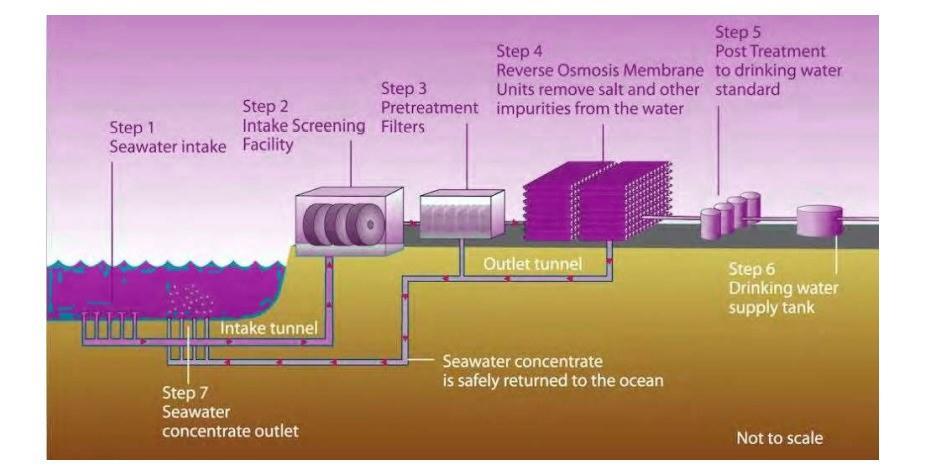THE DESALINATION UNITS
Abstract - Water is the foundation of our economy; safe and sufficient water supplies are essential for agricultural production, industry, recreation, andhumanconsumption. We face increasing water supply challenges as a nation as a result of extended droughts, population growth, polluted water bodies, and competing demands from a variety of users. To meet these challenges in the coming decades, water treatment technologies, which include desalination, will make a significant contribution to ensuring India's safe, sustainable, cost effective, and appropriate water supply. Ifbrackish or salt water is available, desalination is commonly usedto overcome freshwater scarcity in some parts of the world. Various technologies have been proposed over the last century. The state of the mainstream solution, such as reverse osmosis, is reported in this report (RO). In this case, In this case, seawater treatment plants are the same as traditional ones, with the exception that they are designed to be portable. The overview describes the purification techniques and the development of the unit to be compact, usable without complex installation procedures, and capable of treatingseawater anywhere. Thus, classifications are first introduced, taking into account the operating principle, the primary energy input treatment, the components required, the process involved, and the unit's testing.
Key Words: Desalination, reverse osmosis, treatment, compact, polluted water bodies, brackish water, sea water
1. INTRODUCTION
Water resources are groundwater sources resources that havethepotentialtobeusedasasourceofwater.Only3% ofthewateronEarthisfreshwater,withslightlymorethan two-thirds frozen in glaciers and polar ice caps. The remaining unfrozen rainwater is mostly found as groundwater,withonlyatraceabovegroundorintheair. Surface water,under riverflow,ground water,andfrozen waterareallnaturalsourcesoffreshwater

1.1 Motivation of need
Followingtheexpectedpopulationgrowthby2050,India's demand for safe and dependable water quantities will continue to rise. Furthermore, in the absence of other sustainable water sources, desalination is the only viable option for meeting domestic, public, and industrial water demand.Itnotonlyaddressesimmediatewaterneeds,but alsoplaysanimportantroleinaddressingIndia'slong-term water security issue. While our country is implementing
desalination plants to reduce fresh water scarcity, these plantsrequireasignificant amountofland,building,time, money,andwaterproductioncapacity.Theywillnotbeable to provide water to every location, so installing handheld desalinationunitswillsolvetheproblem
1.2 Water Resources in India
Precipitation, surface and ground water storage, and hydropowerpotentialareallpartofIndia'swaterresources. The average annual precipitation in India is 1,170 millimetres. The majority of the rain falls during the monsoonseason(July-September),withthenorthernand north receiving far more rain than the west and south of India. Aside from rain, the melting of snow over the Himalayasattheendofthewinterseasoncontinuestofeed thenorthernriverstovaryingdegrees.Thesouthernrivers, ontheotherhand,havegreaterflowvariabilitythroughout theyear.Thiscausesinundationinsomemonthsandwater scarcity in others in the Himalayan basin. Despite its extensive river system, safe clean drinking water and irrigationwatersuppliesforsustainableagriculturearein shortsupplyacross India,in partbecausethecountryhas only harnessed a small portion of its obtainable and recoverable surface water resource. Desalination technologieshaveattractedalotofattentionas sourcesof water to combat water scarcity. Desalination is typically deemedtobemoreexpensivethanotherexistingsources, but it is more dependable in meeting the country's water

needs because India has 7516.6 km of coastline with unlimitedaccessseawater.
2. DESALINATION
Natural desalination has occurred on Earth since the seas wereformed.Waterevaporatesfromtheseaandcondenses toformpurerain.Forover2000years,humanshaveused distillationto desalinate water. The processcan be traced back to the 4th century B.C., when Greek sailors used an evaporative process to desalinate seawater. The recent discoveryofoilinthearidregionofArabianGulfcountries hasmadea significantcontributiontothedevelopment of the region. Plants for thermal desalination by mid-2007, desalination processes in Middle Eastern countries accountedforapproximately75%oftotalglobaldesalinated water capacity. Although there are several methods for converting seawater to fresh water, all schemes follow a similaroverallprocess.Theexactnatureofeachstepwould be determined by the desalination method used. Figure 1 depictsthestepsintheprocess.Thetypeofpretreatmentis determined by the type of intake system and the level of pollution in the around it sea. Water may be directly obtained from superficial bays near the shore. provide seawatercontainingahighconcentrationofbacteria,algae, andsuspendedsolidsSeawaterdrawnfromtheopenocean istypicallycleanerandrequiresfewerpre-treatmentsteps. Rawfeedwatermustbepre-treatedtoextendthelifeand reliability of the membrane separation machinery. As previouslystated,thereareseveralmethodsforconverting saltwatertofreshwater.Regardlessofconversionmethod, theproductwatermusthavea total dissolvedsolid(TDS) materialofthelessthan500ppm.
OBJECTIVE
1. Investigate the use of desalination in having met the world'swaterneeds.

2.Totreathighlysalinemoisturesothatthewaterissuitable fordrinking.
3.Tocreateasmall,portabledevicethatiseasytouse.
4.Naturaldisasters,suchasdrought,areresolvable.
METHODOLOGY

The study was conducted to address the fresh water problem using various research papers, articles, and backlink tothe goal wewantedtoachieve.Theflowchart belowdepictsthestepstakentoconductresearch.osmosis processpasses waterthroughwitha seriesoffilters,with thecleanwatereventuallygoingtotheholdingtankandthe contaminantsbeingflusheddownthedrain.
ReverseOsmosis(RO)
Thereverseosmosiswaterpurificationprocessprocessis straightforward. Water pressure is used to force tap seawater membrane, removing contaminants from the water. This is a method of removing dissolved inorganic solidsfromasolution.Thismethoddiffersfromtraditional filtrationinthatparticulatesaregatheredwithinthefilter material.Thereverseosmosisprocesspasseswaterthrough withaseriesoffilters,withthecleanwatereventuallygoing to the holding tank and the contaminants being flushed downthedrain.
Membranes
ROmembraneslackdistinctporesthatcircumnavigatethe membraneandareatoneendofthespectrumofavailable commercially membranes. The plastic material of Porous materials forms a layered, internet structure, as well as watermusttravelthroughthemembraneinatortuousway toreachingthepermeateside.
Desalination feed water
Forfeedwater,seawaterROplantshavedifferentoptions: seawater wells (beach wells) or groundwater (open seawaterintake).
Around the world, typical seawater concentrations range fromlessthan35,000mg/Ltomorethan45,000mg/L.TDS is commonly used to represent concentration (Total Dissolved Solids). The TDS level indicates whether the drinkingwaterissafetodrink,needsfiltration,orisheavily polluted.permillion(PPM)istheunitofmeasurementfor measuringTDSlevelsinwater.
Pre-treatment for seawater
ThemainobjectiveofanyROpre-treatmentsystem(forsalt waterorbrackishwater)istoreducewaterfoulingintheRO
membranesystem.Surfacewaters(seawaterandsaltwater) havea higherpriority .membranefoulingandnecessitate more identifying activities systems than groundwater resources Acid addition, coagulant/ flocculant addition, wastewater treatment, mainstream press filtration, and cartridge filtration are all common components of conventionalpre-treatment.Thefeedwaterispreparedfor granularmediafiltrationwiththefirstchemicaladditions, whichincludeanacid,coagulant,andflocculant.ThepHof the feed water is reduced by acid treatment (typical pH range5-7),whichtendstoincreasethesolubilityofcalcium carbonate,themainsolutionwillturninmanyfeedwaters. Sulfuricacidisthemostcommonlyusedacidtoreducethe pHoffeedwater(H2SO4).
Desalination Process in Desalination Plant

Becauseyouwanttodesalinatepureseawater,waterisfirst filtered through intake filters to remove any particles, biologicalmatter,oranythingelsethatmakesitimpure.The desalinationprocessisveryeffectiveatremovingsaltand nothingelse.Thesewhichwasbeforefilterscanbemadeof sandorultrafiltrationmembranes.
Step three: Pre-treatment
Following that, the water is pumped through additional filtersknownascartridgefiltersand
Carbonfiltersareusedtoensurethatthewaterispure.In thiscase,thecartridgeremovesmicroparticles.
A carbon filter, on the other hand, removes bacteria or viruses.
Step four: Reverse osmosis
The salt must then be removed from the water. This is accomplishedthroughaprocessknownasreverseosmosis (RO).Athighpressure,waterisforcedthroughasequenceof verythin membranes with roughlyparticleholesin them. Watermolecules(H2O)passthroughthesemembranes,but salt remains on the other side. Water is pumped through risingpumps,whichconsumethemajorityoftheenergyand pressurisethewater.Apressuregradientof500metreswas requiredfortheROprocess(50bar).Toovercomeosmotic pressure,waterispressurised,whichalsoaidsinpushingit throughthisextremelyfinemembrane.
Step five: Post Treatment.
Reverseosmosisdoesnotproducedrysaltandwater–.It's both pure and also very salty water. Here, half of the seawaterispurified,andtheotherhalfisreturnedtothesea attwicethesalinity.
Step one: Obtaining seawater
First,asourceofseawaterorbrackishwater(amixtureof sea and freshwater) is required. Ordinarily, seawater is piped in slowly from a depth of at least 5 metres in the ocean.It'sveryslow-only0.1metrepersecond-sothefish can swim against by the current without being sucked in. The desalination plant is fed with seawater. It's currently devoidoffish,butitcontainsaplethoraofsmallorganisms, particles,andsalt:mostlysodiumchloride,orNaCl,butsome othersubstancesaswell.Seawatercontainsapproximately 37,000milligrammes[ofsodium]perlitre.
Step two is to screen the intake water.
Watermustbepre-treatedbeforeitcanbedesalinated;this careprocedureisidenticaltothatusedforfreshwater.

Buttheother50%stillhasallofthisenergy,soitispassed through an energy recovery device, in which half of the energyisrecovered-asavinggraceformoderndesalination.
Atarateof4meterspersecond,thisdoublysaltedwateris beingpumpedintotheocean.Within50metresofdischarge, this naturally mixes with seawater. Essentially, carbon dioxide has been injected, followed by liquid lime, which addstoughnesstothewaterasaresultofcalcium,makingit drinkable.Theseadditionsalloccuratlevelsrangingfrom1 to 500 ppm. After that, drinking water is collected, and chlorineisdecidedtoaddtodisinfect.Theniteithertendsto leavetheplantoriskeptinlargestoragefacilities.
ADVANTAGES, DISADVANTAGES AND APPLICATIONS
1. Itisthemosteffectivemethodofwatersoftening.
2. Itprovidespeoplewithsafedrinkingwater.
3. All ion atoms and other contaminants will be blockedbythesemi-permeablemembrane.
4. This framework does not use any chemical compoundstopurifywater.
5. Feedwatercanbetakendirectlyfromthesea.
6. Thebuiltassetissimpleandstrongindesign,andit issmallinsize.
1. Thewaterrateofproductionisaround900LPD.
2. When compared to other purifying devices, installationisrelativelysimple.
3. Transportablefromoneplacetoanother.
4. Thesystemisverysimpletomaintain.
5. Because the majority of the components are nonmetallic,thematerial'schancesof
6. corrosionareextremelylow.
Disadvantages
1. Sometimesreverseosmosiscausescloggingofthe entire system, causing a low water rate of production.
2. Itnecessitatesroutinemaintenance.
3. Theappliedpressuremustbegreaterthanthatof theosmoticpressureforthesystemtofunction.
4. Toavoidfouling,themembranemustbecleaned.
Applications
1. Can be widespread used in homes and businesses near coastal areas; can be used in areas prone to flooding,tsunamis,orothernaturaldisasters;
2. affectedarea,whereaccesstocleanwaterisdifficult
3. Canbeutilizedinrural areaswhere freshwater is scarce.
4. Used on commercial cruise ships to solve the problemofstoringdrinkingwater.
5. Canbeusedfortrekking,picnics,andothersimilar activities.
3. RESULT
ThegoalofdevelopingaCOMPACTDESALINATION UNIT was to convert seawater and brackish water intopurewater.Thedesignwasbasedonanactual desalinationplant.
Different materials were studied for the expected outcome, and components were chosen based on their specifications such as compactness, water purification,andproductioncapacity.
Basedonthecomponentschosen,adesalinationprocesswas developed and CAD models were created, after which pressure drop calculations for each filtration media were performed.TDSwasalsodeterminedinaccordancewiththe manufacturer'sguidelinesfortheirspecificproduct.
4. CONCLUSION
Aswaterpollutionandscarcitybecomeamajorconcern,and consumption of water continues to rise, we must lower emissionsandreusewasteinthesomeformoranother,or seek a different water source. To address this issue, a desalination process study was conducted, and a portable SEA WATER RO DESALINATION UNIT was designed. This devicecanbeusedtotreatanytypeofseawater,brackish water, ground water, and so on. Its use can be for both residentialandcommercialpurposesincoastalareas.Andit can be used in areas affected by floods, tsunamis, or any othernaturaldisasterwheregettingfreshwaterisdifficult. Therearemultiplekindsof desalination processesforthe same application, but each has its own limitations; to overcome these, a compact, user-friendly, innovative, and simpledesigniscreated.Futureresearchcouldbeusefulin discoveringnewtechniquesforincreasingoutputintermsof water manufacturing and using low pressure for smooth operation,whichcansaveenergyandimproveperformance.
REFERENCES
[1]AhmedS.Sabry,YehiaM.Youssef,andKhaledS.El-Kilany “Productivity Prediction of Sea Water Reverse Osmosis DesalinationPlantUsingRobustRegression”,Proceedingsof theInternationalConferenceonIndustrialEngineeringand OperationsManagementNsukka,Nigeria,5-7April,2022
[2] Domenico Curto et al, “A Review of the Water Desalination Technologies”, Research gate publications, January2021.

[3] P. Prusty and S.H. Farooq “Seawater intrusion in the coastal aquifers of India - A review”, Research gate publications,July2020
[4] Usama Ezzeghni et al, “Design of 10000 m3d SWRO desalinationplant.”,Researchgatepublications,September 2016.
[5] Alfred Mutai “A research paper on desalination in Australia”,Researchgatepublications,November2013.
[6]LaurenF.Greenleeetal,“Reverseosmosisdesalination: Watersources,technology,andtoday’schallenges”Science Direct,March2009.
